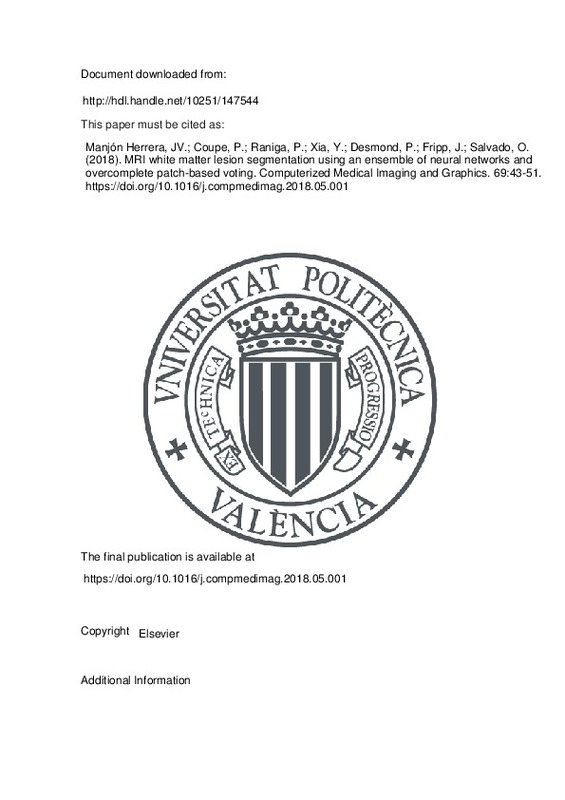JavaScript is disabled for your browser. Some features of this site may not work without it.
Buscar en RiuNet
Listar
Mi cuenta
Estadísticas
Ayuda RiuNet
Admin. UPV
MRI white matter lesion segmentation using an ensemble of neural networks and overcomplete patch-based voting
Mostrar el registro sencillo del ítem
Ficheros en el ítem
| dc.contributor.author | Manjón Herrera, José Vicente
|
es_ES |
| dc.contributor.author | Coupe, Pierrick
|
es_ES |
| dc.contributor.author | Raniga, Parnesh
|
es_ES |
| dc.contributor.author | Xia, Ying
|
es_ES |
| dc.contributor.author | Desmond, Patricia
|
es_ES |
| dc.contributor.author | Fripp, Jurgen
|
es_ES |
| dc.contributor.author | Salvado, Olivier
|
es_ES |
| dc.date.accessioned | 2020-07-07T03:33:34Z | |
| dc.date.available | 2020-07-07T03:33:34Z | |
| dc.date.issued | 2018-11 | es_ES |
| dc.identifier.issn | 0895-6111 | es_ES |
| dc.identifier.uri | http://hdl.handle.net/10251/147544 | |
| dc.description.abstract | [EN] Accurate quantification of white matter hyperintensities (WMH) from Magnetic Resonance Imaging (MRI) is a valuable tool for the analysis of normal brain ageing or neurodegeneration. Reliable automatic extraction of WMH lesions is challenging due to their heterogeneous spatial occurrence, their small size and their diffuse nature. In this paper, we present an automatic method to segment these lesions based on an ensemble of overcomplete patch-based neural networks. The proposed method successfully provides accurate and regular segmentations due to its overcomplete nature while minimizing the segmentation error by using a boosted ensemble of neural networks. The proposed method compared favourably to state of the art techniques using two different neurodegenerative datasets. (C) 2018 Elsevier Ltd. All rights reserved. | es_ES |
| dc.description.sponsorship | This research has been done thanks to the Australian distinguished visiting professor grant from the CSIRO (Commonwealth Scientific and Industrial Research Organisation) and the Spanish "Programa de apoyo a la investigacion y desarrollo (PAID-00-15)" of the Universidad Politecnica de Valencia. This research was partially supported by the Spanish grant TIN2013-43457-R from the Ministerio de Economia y competitividad. This study has been carried out also with support from the French State, managed by the French National Research Ageny in the frame of the Investments for the future Program IdEx Bordeaux (ANR-10-IDEX-03-02, HL-MRI Project), Cluster of excellence CPU and TRAIL (HR-DTI ANR-10-LABX-57) and the CNRS multidisciplinary project Defi imag'In. Some of the data used in this work was collected by the AIBL study group. Funding for the AIBL study is provided by the CSIRO Flagship Collaboration Fund and the Science and Industry Endowment Fund (SIEF) in partnership with Edith Cowan University (ECU), Mental Health Research Institute (MHRI), Alzheimer's Australia (AA), National Ageing Research Institute (NARI), Austin Health, Macquarie University, CogState Ltd, Hollywood Private Hospital, and Sir Charles Gairdner Hospital. | es_ES |
| dc.language | Inglés | es_ES |
| dc.publisher | Elsevier | es_ES |
| dc.relation.ispartof | Computerized Medical Imaging and Graphics | es_ES |
| dc.rights | Reconocimiento - No comercial - Sin obra derivada (by-nc-nd) | es_ES |
| dc.subject | Lesion segmentation | es_ES |
| dc.subject | MRI | es_ES |
| dc.subject | Brain | es_ES |
| dc.subject | Patch-Based | es_ES |
| dc.subject | Neural network | es_ES |
| dc.subject | Ensemble | es_ES |
| dc.subject.classification | FISICA APLICADA | es_ES |
| dc.title | MRI white matter lesion segmentation using an ensemble of neural networks and overcomplete patch-based voting | es_ES |
| dc.type | Artículo | es_ES |
| dc.identifier.doi | 10.1016/j.compmedimag.2018.05.001 | es_ES |
| dc.relation.projectID | info:eu-repo/grantAgreement/UPV//PAID-00-15/ | es_ES |
| dc.relation.projectID | info:eu-repo/grantAgreement/ANR//ANR-10-LABX-0057/FR/Translational Research and Advanced Imaging Laboratory/TRAIL/ | es_ES |
| dc.relation.projectID | info:eu-repo/grantAgreement/ANR//ANR-10-IDEX-0003/FR/Initiative d’excellence de l’Université de Bordeaux/IDEX BORDEAUX/ | es_ES |
| dc.relation.projectID | info:eu-repo/grantAgreement/MINECO//TIN2013-43457-R/ES/CARACTERIZACION DE FIRMAS BIOLOGICAS DE GLIOBLASTOMAS MEDIANTE MODELOS NO-SUPERVISADOS DE PREDICCION ESTRUCTURADA BASADOS EN BIOMARCADORES DE IMAGEN/ | es_ES |
| dc.rights.accessRights | Abierto | es_ES |
| dc.contributor.affiliation | Universitat Politècnica de València. Departamento de Física Aplicada - Departament de Física Aplicada | es_ES |
| dc.description.bibliographicCitation | Manjón Herrera, JV.; Coupe, P.; Raniga, P.; Xia, Y.; Desmond, P.; Fripp, J.; Salvado, O. (2018). MRI white matter lesion segmentation using an ensemble of neural networks and overcomplete patch-based voting. Computerized Medical Imaging and Graphics. 69:43-51. https://doi.org/10.1016/j.compmedimag.2018.05.001 | es_ES |
| dc.description.accrualMethod | S | es_ES |
| dc.relation.publisherversion | https://doi.org/10.1016/j.compmedimag.2018.05.001 | es_ES |
| dc.description.upvformatpinicio | 43 | es_ES |
| dc.description.upvformatpfin | 51 | es_ES |
| dc.type.version | info:eu-repo/semantics/publishedVersion | es_ES |
| dc.description.volume | 69 | es_ES |
| dc.relation.pasarela | S\384863 | es_ES |
| dc.contributor.funder | Cogstate Ltd | es_ES |
| dc.contributor.funder | Macquarie University | es_ES |
| dc.contributor.funder | Alzheimer's Australia | es_ES |
| dc.contributor.funder | Edith Cowan University | es_ES |
| dc.contributor.funder | Ministerio de Economía y Empresa | es_ES |
| dc.contributor.funder | Universitat Politècnica de València | es_ES |
| dc.contributor.funder | Sir Charles Gairdner Hospital, Australia | es_ES |
| dc.contributor.funder | Agence Nationale de la Recherche, Francia | es_ES |
| dc.contributor.funder | Mental Health Research Institute, Australia | es_ES |
| dc.contributor.funder | National Ageing Research Institute, Australia | es_ES |
| dc.contributor.funder | Hollywood Private Hospital Research Foundation | es_ES |
| dc.contributor.funder | Science and Industry Endowment Fund, Australia | es_ES |
| dc.contributor.funder | Centre National de la Recherche Scientifique, Francia | es_ES |
| dc.contributor.funder | Commonwealth Scientific and Industrial Research Organisation | es_ES |







![[Cerrado]](/themes/UPV/images/candado.png)

